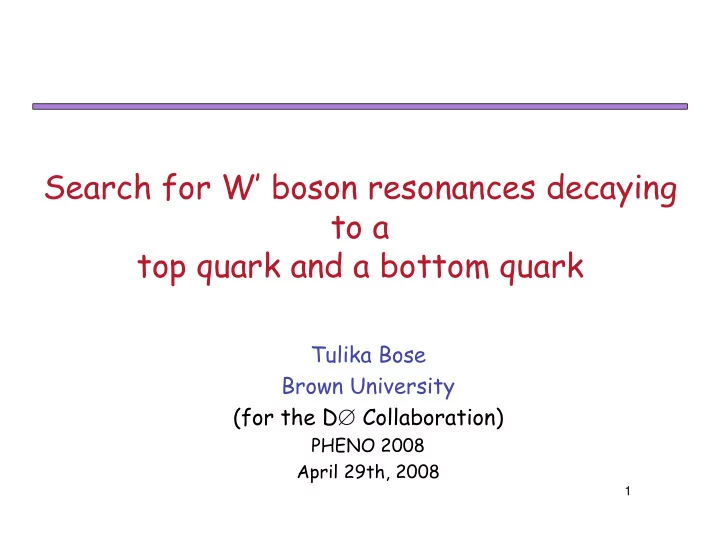

Search for W’ boson resonances decaying to a top quark and a bottom quark Tulika Bose Brown University (for the D � Collaboration) PHENO 2008 April 29th, 2008 1
Motivation • Heavy gauge bosons (W’, Z’) are predicted by many extensions to the SM – Composite and Little Higgs models, Left-right symmetric models, GUTs, UED, Technicolor… • The single top quark decay channel is a promising searching ground for a W’ that interacts hadronically – Relatively small multijet background in comparison to light jet channels Looking for W � tb � or W � t � b 2
Production Mechanism • Three different channels possible: – s-channel, t-channel, associated tW channel – Only s-channel is interesting (resonance) • The effective Lagrangian for W’ interactions with SM fermions f (generation indices i,j) can be written in a model independent form: V ij g W f i � μ a ij [ ] R (1 + � 5 ) + a ij L (1 � � 5 ) L = W f j + h . c . � 2 2 3 Right and left couplings of W’ to quarks
Three of a kind 2 = SM + 2 � a ud L � a tb L � W � W ' Interference ( ) + M L ) 2 ( a tb L ) 2 + ( a ud R ) 2 ( a td R ) 2 L ) 2 ( a tb R ) 2 + ( a ud R ) 2 ( a td L ) 2 [ ] W ' [ ] W ' ( ) + ( a ud ( ) ( a ud • Three different cases arise: L = a tb L = 1, a ud R = a tb R = 0 a ud – Purely left handed W’ R = a tb R = 1, a ud L = a tb L = 0 a ud – Purely right handed W’ L = a tb R = a tb L = a ud R = 1 – Left-Right mixed a ud • W-W’ interference term is proportional to the left couplings only 4
Analysis Strategy Look at purely left-handed and right-handed W’ – L-handed W’ bosons that interfere with the SM W->tb process – R-handed W’ bosons that do not have the SM interference Case a) M � R < M_W’ – Leptonic decay channels are open (l,q) – Same cross-section as W’ L with no interference Case b) M � R > M_W’ – Only decays to quarks are allowed (qq) – W’ R cross section x B(W’->tb) larger than that of Case (a) Interference contribution is important and should be taken into account in simulation (Phys. Lett. B 655, 245, 2007) May reduce the total rate by as much as (16-33)% (depends on W’ mass and its couplings) 5
W’ Parton level plots The right-handed l,q and qq sampes have similar shape Destructive interference 6
Event Selection • 1 isolated lepton – Electron: p T > 15 GeV, | � | < 1.1 – Muon: p T > 18 GeV, | � | < 2.0 • Missing transverse energy > 15 GeV • At least one b-tagged jet and at least one more jet – 2-3 jets with p T > 15 GeV, | � | < 3.4 – Leading jet p T > 25 GeV, | � | < 2.5 – Second leading jet p T > 20 GeV • High efficiency of b-tagging using a neural net tagger 7
Analysis Method Four-vectors of all final state objects are added to obtain the invariant mass of the W’ boson (“s-hat” or � s) : “s-hat” is used to separate W’ from background 8
Background Modeling W’ L W’ R 9
Event Yields Observe no significant excess of events in the final-state invariant mass distribution Use the distribution to set limits… ˆ s 10
Results: W’ L Using the nominal (nominal - 1 � ) NLO x-section Limit: 731 (718) GeV 731 GeV 11
Results: W’ R Using the nominal (nominal - 1 � ) NLO x-section Limit: qq: 768 (750) GeV ; l,q: 739 (725) GeV 739 768 12
Coupling Strength • Can convert the measured limits to limits on the coupling strength: • The leading order s-channel production process has two W’qq’ vertices – Thus � (p p �� W’) x B(W’ �� tb) is proportional to g’ 4 • g’ depends on the model being used and is either g R or g L . – In models with non-SM couplings (g’ � g W ) the reconstructed W invariant mass distribution could be identical to the g’ = g W case but with a normalization that would differ by a factor of g’ 4 /g 4 W . • W’ coupling strength limit is calculated from the fourth root of the ratio of the experimentally excluded W’ cross-section and the cross- section with SM couplings. 13
Coupling Strength Exclude gauge couplings above 0.68 (0.72) g W @ M W’ = 600 GeV 14
Conclusions & Outlook • We have performed a search for W’ bosons in the single top decay channel • We have no evidence for a W’ boson • 95% C.L. confidence limits have been set – Both masses and couplings • D � (0.9 fb -1 ): – W’ mass > 731 GeV [Left-handed; with interference] – W’ mass > 739 GeV [Right handed; W’ � l � and W’ � qq’] – W’ mass > 768 GeV [Right handed; W’ � qq’ only] – Also set limits on the coupling of W’ to fermions as a function of W’ mass • For more information: arXiv.org:0803.3256, submitted to PRL • Looking forward to adding more data… 15
Recommend
More recommend